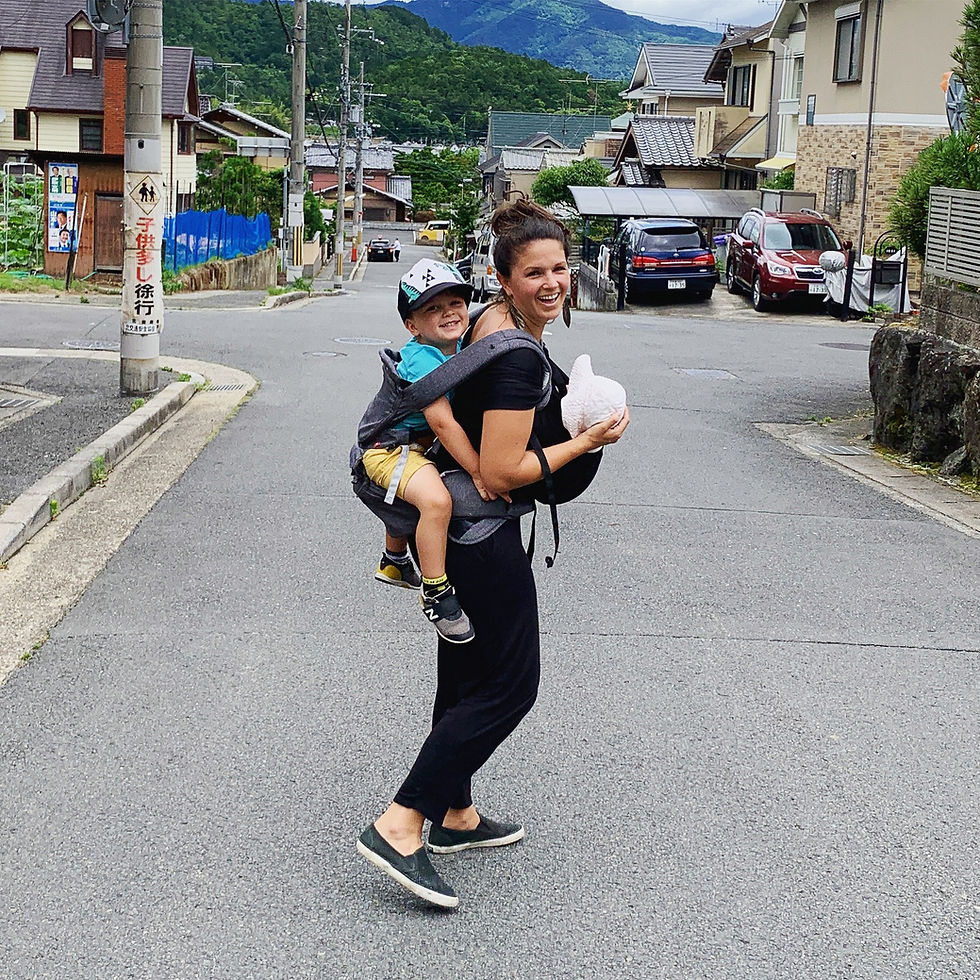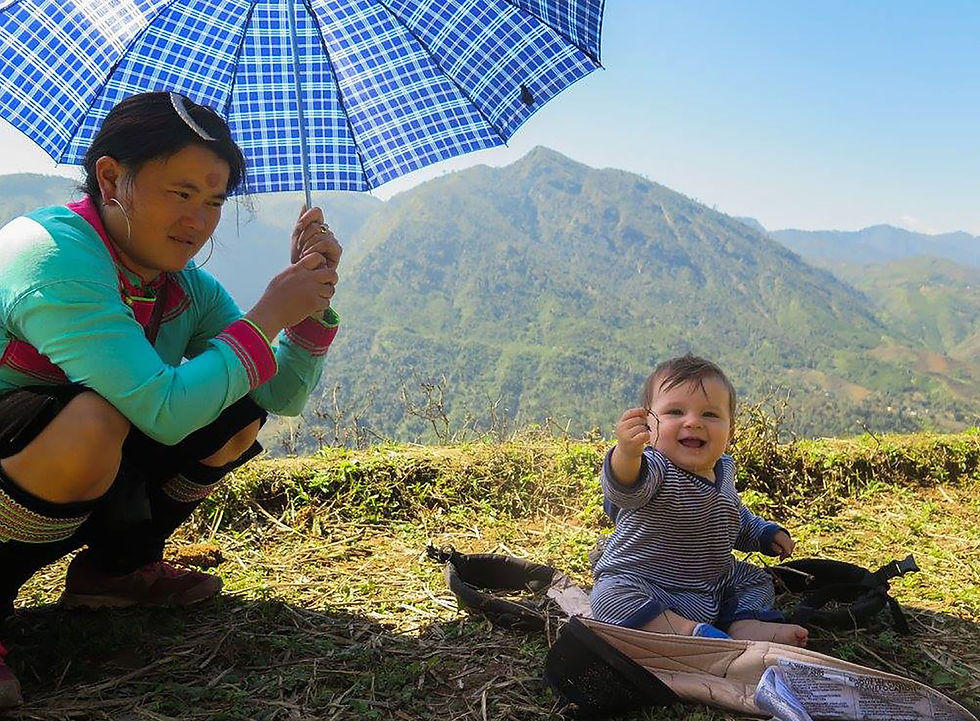Tips for traveling in Japan with kids
- Admin
- Aug 28, 2019
- 6 min read
Updated: Jan 16, 2023
Japan: I can best describe it as a beautiful result of countless contradictions. It's a country of strict work habits and school on Saturday but also of cutsie cartoons and crazy fashion. It's a conservative country where I felt a little uncomfortable breastfeeding in public, but also a country that has maid cafe's and a poppin' red light district. It's a country of old traditions and a culture steeped in history but the most advanced technology and systems I've ever seen. It's a place where you can be in a completely crowded restaurant, but still be able to hear a pin drop. A country that has the busiest subway station in the entire world, but somehow remains unbelievably clean and organized.

We traveled to Japan as our first international trip as a family of four. Our little girl was 2 months old at the time, and we chose to go to Japan because of it reputation of being a clean and safe country with great medical care if we needed it. I would say it's a great place to travel with infants and toddlers for different reasons. For infants, the cleanliness was a plus. For toddlers, there are a lot of activities, parks to see wild animals, and fun foods for your little one to try.
If you're gearing up for a trip to Japan, here are some things to know to get prepared.
HOW TO GET AROUND
BY TRAIN
We found Japan to be an incredibly easy country to travel around in. Japan Rail has set up a rail pass for tourist in Japan to pay a baseline price depending on how many days you need it for (7, 14, or 21) and you can access most of the country with no additional cost—even for a lot of the bullet (Shinkansen) trains.
From the US and Canada, you can purchase your tickets here. Purchase the voucher online and Jrail will send it to you wherever you are in the world within 7 days. Once you arrive at the airport in Japan, you can validate your voucher and get your passes at the JRail office to use immediately. If you are last minute travelers and don’t order them in time to reach the States (ahem, like us), you can get them sent to your hotel in Japan. I was a little bit stressed that they wouldn’t arrive, but just like most things in Japan, it worked as it should and our vouchers were at our hotel in Tokyo waiting for us upon our arrival.

People always ask us if it was hard to navigate the train stations in Japan because
of the language barrier. It was actually very easy since all the signs were in English
too and the Jrail employees were always very helpful.
Before leaving for Japan, I was a little confused about how we could use the passes and figuring out routes. I didn’t need to be. What’s great about the Jrail pass is that in each train station, there is a Jrail office with someone who speaks at least a little bit of English. They can tell you exactly how you get to where you’re going, get you tickets for the train, and set it all up for you. I was blown away with how simple it was. Additionally, I found the Japan Travel by Navitime app incredibly helpful. Since there are multiple train companies within Japan, you can find a route using just your Japan Rail Pass to get from point A to point B (both across the country or within a city) to save you money.
An added bonus is that kids under the age of 6 ride for free. Just know that they are not guaranteed a seat on the train and may have to sit in your lap if the train is full. However, besides one short leg of the train from Tokyo to Kyoto, we were on pretty empty trains where we just snagged an extra seat for our 3 year old.
BY CAR
I felt like we were able to get around well with the train. We didn’t have to take a taxi once, and everywhere we went, public transportation was so well set up. But, if you want some freedom and want to explore some smaller towns in Japan, you may want to rent a car. For US citizens, you will need to get an international drivers license to rent a car in Japan.
I wouldn’t advise you to rent a car to save money. From what I've heard, though a rental may be cheap, the subsequent costs of tolls, gas, and parking rack up quite quickly.
INTERNET
If you like to make life easier with minimal cost, I would highly suggest getting a pocket wifi router for your trip in Japan. This thing came in so clutch. We got great internet wherever we were which made navigating and communicating (using Google Translate) easier. We rented one from Get Your Guide, and if you haven't sensed a trend, they made it super easy to receive upon arrival in Japan and return when you leave. You can pick it up from a designated location, or even easier: they send it to your hotel for free, and they give you the return envelope to drop it in the mail before you leave the country. So easy!
I would also highly suggest getting a portable charger for your trip since you'l be using your phone a lot to navigate. The Anker Power Core Portable Charger is compact, low cost, works well, and is highly rated.

Here we are, lost somewhere outside of Kyoto after we took the wrong bus then ran out of
phone battery and couldn't find our way back. Loved the adventure,
but a portable charger would have come in handy!
DIAPERS
We had a hard time finding small packages of diapers for our 2 month old daughter. They do have packs of 4 diapers in Family Marts and 7/11s, but they are size large which are for bigger toddlers. They actually worked for our 11 pound baby, so it wasn't that bad, but you may want to bring enough diapers for your trip if that's a concern.

WHAT TO KNOW BEFORE YOU GO
1. The Japanese have an incredible talent of keeping a crowded room close to silent. With an energetic toddler, it's sometimes harder to keep with the noise level. Really nothing you can do about it except mentally prepare.
2. The debate to take a stroller or not take a stroller. We did not take one and we have no regrets--just the opposite actually. It would have been a hassle to have a stroller and the carriers we brought for our two kids worked perfectly.

3. Important words to know when traveling with a kids (especially toddlers): Sorry and Excuse Me
Sorry: Gomen'nasai
Excuse Me: Sumimasen
Thank you: Arigatōgozaimashita
4. People are very respectful in Japan. Even in the most crowded train stations, everyone lines up on the left side of the escalator to allow people walking up the stairs on the right to pass. They also line up on the side of the train to allow people exiting to do so first.in train stations, so be sure to encourage your child to be respectful of the rules and customs. I was truly blown away with how well organized it was, especially since I used to live in New York City where it's a complete cluster f^%$.
5. There's plenty of food for even the pickiest eaters in Japan. If our son wasn't into the ramen or sushi that we were eating, he could have rice and chicken, or Tamagoyaki, the Japanese version of an omelet. And if all else fails, there are 7/11s and Family Marts around every corner with plenty of food (quality food options) available. I still dream about the 7/11 egg sandwich.

6. Japan as a whole really cater to parents with babies. We found that there were always family bathrooms and baby changing stations available. Even on the train, there are all-purpose rooms called Tamokuteki Shitsu. The ticket employee has a key that you can ask for.

...and when a baby changing station can't be found, luckily everything is pretty spotless.
Here I am changing Lai's diaper by the cleanest dumpster I've ever seen.
7. Cash is king in Japan. We rarely used our credit card, so be sure to take out plenty of cash. Or, if you don't have ATM fees, you can take money out whenever you need it as ATMs are ubiquitous around the country.
8. People don't eat on the go. For a kid that's used to snacking a lot, it might be difficult to adjust, but just another reason to take it slow and soak it all in. For longer train rides however, eating meals and snacks is totally fine.












Comments